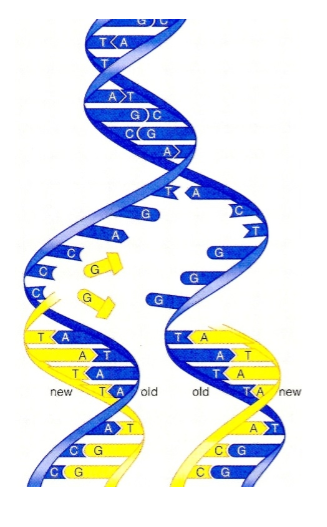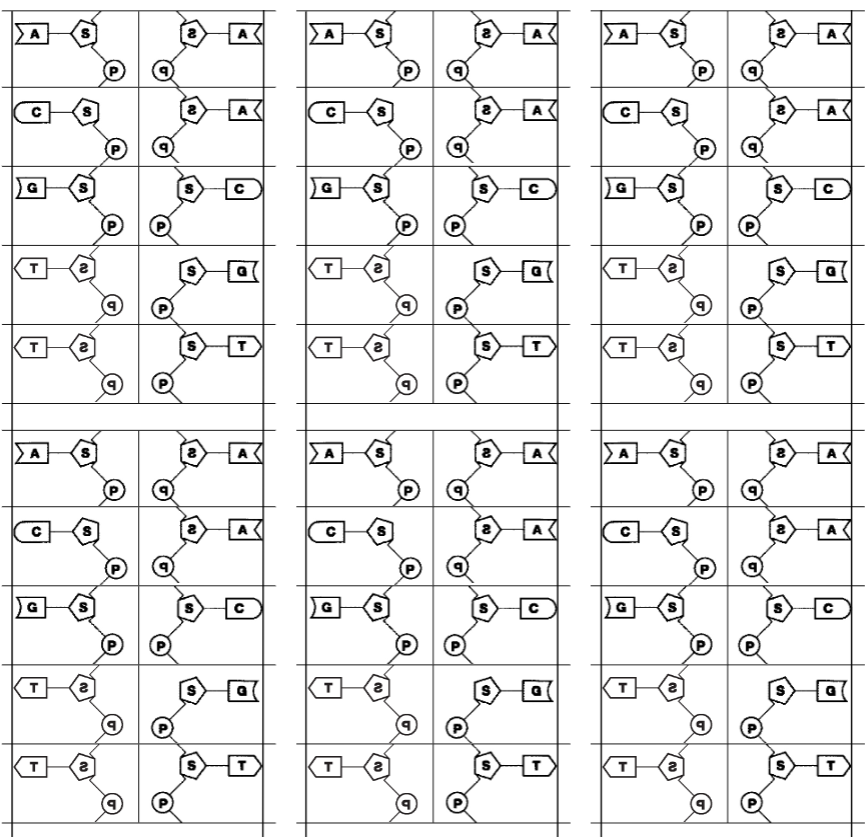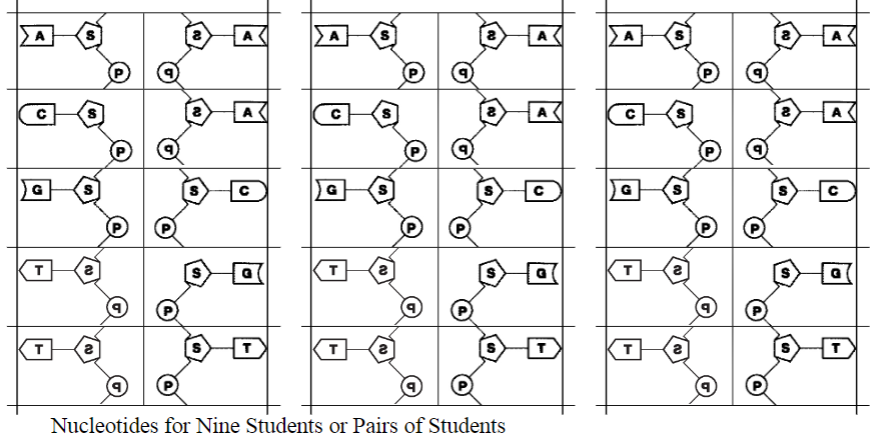7.2: DNA Teacher's Preparation Notes
- Page ID
- 25148
Overview
In this activity, students extract DNA from their cheek cells and relate the steps in the procedure to the characteristics of cells and biological molecules. Students learn key concepts about DNA function during the intervals required for the extraction procedure. Student understanding of DNA structure, function and replication is further developed by additional analysis and discussion questions and hands-on modeling of DNA replication.
If school policies do not allow your students to extract DNA from their cheek cells, we recommend the directions for extracting DNA from strawberries (available at https://sites.google.com/site/biolog...ical-molecules) or the DNA Extraction Virtual Lab (available at http://learn.genetics.utah.edu/conte...bs/extraction/), either of which can be used together with our analysis and discussion activity "DNA Structure, Function and Replication" (available at http://serendip.brynmawr.edu/exchange/ bioactivities/DNA).
Learning Goals
In accord with the Next Generation Science Standards:
- Students will gain understanding of the Disciplinary Core Ideas:
- LS1.A, Structure and Function, "All cells contain genetic information in the form of DNA molecules. Genes are regions in the DNA that contain the instructions that code for the formation of proteins."
- LS3.A, Inheritance of Traits, "Each chromosome consists of a single very long DNA molecule, and each gene on the chromosome is a particular segment of that DNA. The instructions for forming species' characteristics are carried in DNA."
- Students will engage in the Scientific Practices, constructing explanations and using models.
- This activity provides the opportunity to discuss the Crosscutting Concept, "structure and function".
- This activity helps to prepare students for two Performance Expectations:
- HS-LS1-1, "Construct an explanation based on evidence for how the structure of DNA determines the structure of proteins which carry out the essential functions of life..."
- MS-LS3-1, "Develop and use a model to describe why structural changes to genes located on chromosomes may affect proteins and may result in harmful, beneficial, or neutral effects to the structure and function of the organism."
Specific Learning Goals
- DNA carries the genetic information in all types of living organisms. Each DNA molecule contains multiple genes.
- DNA consists of two strands of nucleotides wound together in a spiral called a double helix. Each nucleotide is composed of a phosphate group, a sugar molecule, and one of four different nitrogenous bases: adenine (A), thymine (T), guanine (G), or cytosine (C). The phosphate and sugar parts of the nucleotides form the backbone of each strand in the DNA double helix.
- The bases extend toward the center of the double helix, and each base in one strand is matched with a complementary base in the other strand. In accord with the base-pairing rules, A pairs with T and G pairs with C.
- A polymer consists of many repeats of a smaller molecule (a monomer). DNA is a polymer of nucleotides.
- Proteins are polymers of amino acids. The specific sequence of amino acids determines the structure and function of the protein. Proteins have many important functions in cells, including protein enzymes that catalyze chemical reactions, transport proteins and structural proteins.
- The sequence of nucleotides in a gene gives the instructions for the sequence of amino acids in a protein. A difference in the sequence of nucleotides in a gene can result in a different sequence of amino acids which can alter the structure and function of the protein. This can result in different characteristics, e.g. albinism vs. normal skin and hair color.
- DNA replication produces two new DNA molecules that have the same sequence of nucleotides as the original DNA molecule, so each of the new DNA molecules carries the same genetic information as the original DNA molecule. During DNA replication, the two strands of the original DNA double helix are separated and each old strand is used as a template to form a new matching DNA strand. The enzyme DNA polymerase adds nucleotides one-at-a-time, using the base-pairing rules to match each nucleotide in the old DNA strand with a complementary nucleotide in the new DNA strand.
- In eukaryotic cells, each chromosome consists of DNA wrapped around proteins. The chromosomes are contained in the nucleus inside a nuclear membrane.
Equipment and Supplies for DNA Extraction
- Sports drink like Gatorade (10 mL per student)
- Liquid dish soap (0.25 mL per student)
- Meat tenderizer (a pinch per student)
- 70-95% isopropyl or ethyl alcohol (4 mL per student)
- String for necklace (2.5 ft per student)
- 3 oz. dixie cups (1 per student)
- Tub of ice, freezer, or refrigerator (1)
- Tub for dirty test tubes (1)
- Bleach (1% bleach solution to sterilize test tubes)
- Small test tubes (tubes need to hold a minimum of 15 mL) (1 per student)
- Test tube rack (1 per group)
- 0.5-1.5 mL fliptop microcentrifuge tubes (1 per student)
- Transfer pipettes (1 per group)
- Gloves (1 per student)
Preparations for DNA Extraction
Before Class:
- Cut string into 2.5 ft pieces.
- Set up a bucket of ice to keep alcohol cold or put alcohol in the freezer/refrigerator until needed.
- Pour a small cup sports drink for each student.
During class:
- Distribute cups of sports drink to each student. It is important for each student to swish the drink in his or her mouth vigorously for at least a minute in order to obtain enough cheek cells.
- Distribute a test tube rack with one test tube per student to each group. Distribute one glove to each student. Pass out the soap and meat tenderizer. Alternatively, you can have a station somewhere in the classroom where the students can access the soap, etc.
- After at least 10 minutes (when the students have completed the “DNA structure” portion of the student handout), pass out the cold alcohol and pipettes.
- After 10 minutes (when the students have completed the “DNA replication” portion of the student handout), distribute one microcentrifuge tube and piece of string to each student.
- Assist students’ transfer of their DNA to their microcentrifuge tubes using the pipettes. It helps to twirl the DNA around the end of the pipette to get a large wad together before sucking the DNA into the pipette. Warn the students to be gentle while pipetting so they do not damage the fragile strands of DNA. Inexperienced pipetters have a tendency to blow air into the liquid and suck up and expel the DNA several times in the test tube before transferring it to the microcentrifuge tube; this tends to break the DNA strands.
- Put on a pair of gloves and collect the test tube racks from the students. Pour test tube contents out down the sink, rinse the test tubes, and place them in a tub of 1% bleach solution for 10 minutes to sterilize them for the next class. (You may want to assign this job to a student).
- Remove test tubes from bleach water and invert them in the racks to dry for the next class.
- Return the alcohol to the ice bucket or freezer/refrigerator.
Supplies and Preparation for Modeling DNA Replication
- Nucleotide pieces (A template for making enough nucleotide pieces for nine students or pairs of students is provided on the last page of these Teacher Preparation Notes. After you photocopy enough copies for the number of students you have, you can:
- Precut each page in nine parts and provide your students with scissors as well as tape or
- Recruit student helpers to precut each page to make 9 packets of 10 nucleotides each.)
- Tape
Instructional Suggestions and Biology Background
Before students begin the activity, they should have a basic understanding of the structure and function of proteins. A suggested sequence of learning activities for introducing students to proteins and DNA is provided in "Understanding the Functions of Proteins and DNA" (available at http://serendip.brynmawr.edu/exchang...ities/proteins).
Pages 1-3 of the Student Handout will probably require a 50-minute laboratory period. Pages 4-6 will probably require less than a full additional 50-minute period, especially if your students are familiar with DNA structure and replication. In the Student Handout, numbers in bold indicate questions for the students to answer.
If you use the Word version of the Student Handout to make changes for your students, please check the PDF version to make sure that the figures and formatting in the Word version are displaying correctly on your computer.
A key with answers to most of the questions in this activity is available as the key for the analysis and discussion activity “DNA Structure, Function, and Replication”; you can request this key from Ingrid Waldron (iwaldron@sas.upenn.edu). The following paragraphs provide additional instructional suggestions and background information – some for inclusion in your class discussions and some to provide you with the relevant backgrounds that may be useful for your understanding and/or for responding to student questions.
To help students understand the big picture and consolidate their understanding of important principles and vocabulary related to DNA, we recommend that you use this activity together with a modified version of storyboarding. In this approach, students use the DNA Storyboard (shown on the next to the last page of these Teacher Preparation Notes) as follows:
- As students answer question 1 in the Student Handout, they label and explain the figures in the DNA Storyboard. (If your students need more scaffolding, you may want to add more specific questions.)
- As students increase their understanding of DNA in subsequent pages of the Student Handout, they modify their DNA Storyboard.
- After completing the activity presented in the Student Handout, students are given a new copy of the DNA Storyboard. Students label and explain the figures to summarize what they know about DNA structure, function, and replication (without looking at their earlier storyboard or the Student Handout). After this, students should have prompt feedback so they can improve the accuracy and completeness of their storyboards; you can accomplish this in a class discussion where students compare their storyboards. This type of active recall with feedback helps to consolidate student understanding and retention of the concepts and vocabulary learned during the activity.
The proteases in the meat tenderizer not only digest histones (the proteins that DNA wraps around), but also break down cell enzymes which could digest the DNA. The high salt concentration (from the sports drink and meat tenderizer) is also important since DNA molecules are negatively charged and the salt neutralizes the repulsion among the negatively charged strands of DNA and allows the DNA to clump together.
During the wait of at least 10 minutes after the students have added enzymes, students should review the brief introduction to DNA structure and function on page 2 of the Student Handout and answer question 1. This question provides the opportunity to reinforce student understanding that DNA carries the genetic information in all types of living organisms. You may also want to point out that the structure and function of DNA are similar in all types of organisms.
Cold alcohol helps to precipitate the DNA molecules by reducing the temperature and dehydrating the solution of DNA immediately under the alcohol layer. You may want to explain to your students how alcohol helps to precipitate the DNA. DNA is soluble in water because the negatively charged phosphate groups along the sugar-phosphate backbone are attracted to the partial negative charge of the O atoms in the polar water molecules. Ethanol is also polar but has a large nonpolar component, making DNA less soluble in ethanol.
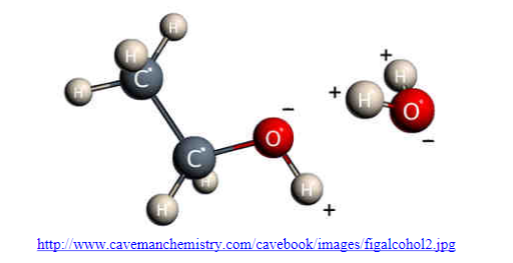
During the wait of at least 10 minutes after the alcohol has been added, the students should read the material on the top of page 3 and answer question 2. Whereas question 1 discusses genes that are crucial for cell function and survival, question 2 refers to an example of a gene that is not crucial for cell function and survival and is only active in certain specific cells.
The allele for albinism codes for a defective enzyme for producing melanin, a dark pigment that protects skin cell's DNA from the damaging effects of the sun's UV radiation. In the most common form of albinism, the defective enzyme for producing melanin not only results in albino skin and hair color but also affects the appearance and function of the eyes. You may want to point out to your students that skin color is also influenced by other genes (e.g. genes that influence how much melanin is made) and environmental factors (e.g. sun exposure which can result in increased production of melanin). Further information about albinism, as well as information on hemophilia, is available in "Understanding the Functions of Proteins and DNA" (http://serendip.brynmawr.edu/exchang...ities/proteins).
After waiting for at least 10 minutes, when your students are ready to examine the extracted DNA, emphasize that they should first look at the undisturbed test tube; they should see a translucent layer where the DNA is located between the original mixture and alcohol, and they may see strands of DNA stretching up into the alcohol layer; sometimes the strands of DNA have bubbles on them.
To ensure student understanding, the Student Handout for this activity includes several simplifications. For example, the definition of a gene near the top of page 2 in the Student Handout ignores multiple complexities, including the facts that many genes code for more than one polypeptide and many genes code for RNA that has different functions from mRNA.
DNA Structure and Function
In discussing the figure on the top of page 4 of the Student Handout, you may want to remind your students that the solid lines represent covalent bonds and the dotted lines represent hydrogen bonds.
The boxed sentence near the bottom of page 4 of the Student Handout provides important background for helping students understand why accurate replication of the sequence of nucleotides in DNA is so important, as discussed further in question 8. You may want to show your students the following illustrated flowchart version of this information.
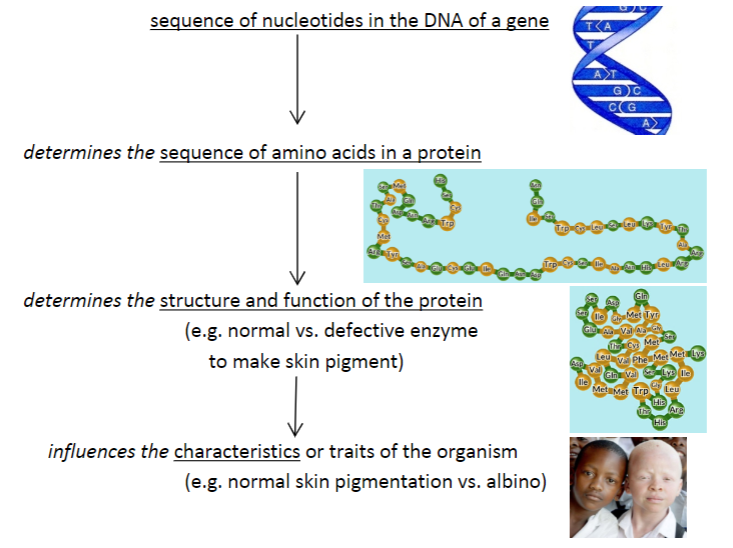
The image shown for the folded protein in this version of the flowchart differs from the image of the protein on page 2 of the Student Handout. The image shown on page 2 is more accurate (http://www.ebi.ac.uk/thornton-srv/da...mber=1.14.18.1); the second and third images in this flowchart are designed to suggest how a polypeptide folds into a functional protein.
DNA Replication
For questions 8-10, after students have written their initial responses and you have had a class discussion of these responses, you may want to offer students the opportunity to prepare revised versions of their answers to one or more of these questions in order to consolidate accurate understanding. For question 9, if your students are not familiar with the use of the suffix "ase" to designate an enzyme, you will need to provide that information.
To ensure student understanding of the basic process of DNA replication, this activity ignores many of the complexities observed in actual DNA replication. For additional information on DNA and DNA replication, see:
- Helpful resources available at http://learn.genetics.utah.edu/content/molecules/ and http://www.hhmi.org/biointeractive/teacher-guide-dna
- A college textbook for biology majors such as Campbell, Reece, et al., Biology; Freeman et al., Biological Science; or Raven et al., Biology
- Videos available at http://www.hhmi.org/biointeractive/c...-structure-dna , http://www.hhmi.org/biointeractive/d...n-basic-detail and http://www.hhmi.org/bioi nteractive/dna-replication-advanced-detail.
One important point that is not included in the Student Handout is that, during actual DNA replication, sometimes mistakes are made and the wrong nucleotide is added to the new strand of DNA. DNA polymerase can “proofread” each new double helix DNA strand for mistakes and backtrack to fix any mistakes it finds. To fix a mistake, DNA polymerase removes the incorrectly paired nucleotide and replaces it with the correct one. If a mistake is made and not found, the mistake can become permanent. Then, any daughter cells will have this same change in the DNA molecule. These changes are called point mutations because they change the genetic code at one point, i.e. one nucleotide. A point mutation in a gene in a gamete that forms a zygote can result in significant effects, such as sickle cell anemia. (Additional information on sickle cell anemia is provided in "Understanding the Functions of Proteins and DNA" (http://serendip.brynmawr.edu/exchang...ities/proteins).)
Follow-Up Activities
To further develop student understanding of how DNA provides the instructions for protein synthesis and influences our characteristics, we recommend our hands-on modeling activity
"From Gene to Protein – Transcription and Translation" (available at http://serendip.brynmawr.edu/sci_edu/waldron/#trans). In this hands-on activity, students learn how a gene provides the instructions for making a protein, and how genes can cause albinism or sickle cell anemia. Simple paper models are used to simulate the molecular processes of transcription and translation. In addition, students evaluate the advantages and disadvantages of different types of models included in this activity. This activity is aligned with the Next Generation Science Standards.
To help students understand how chromosomes are separated during cell division and how genes are transmitted from parents to offspring, we recommend our hands-on modeling activities, Mitosis - How Each New Cell Gets a Complete Set of Genes and Meiosis and Fertilization – Understanding How Genes Are Inherited (available at http://serendip.brynmawr.edu/sci_edu/waldron/#mitosis and http://serendip.brynmawr.edu/sci_edu/waldron/#meiosis, respectively). These minds-on, hands-on activities are designed to be used together and both activities are aligned with the Next Generation Science Standards.
To provide the background needed for both activities, students begin by reviewing the relationships between chromosomes, genes, alleles, proteins, and phenotypic characteristics. Then, students use model chromosomes to simulate the processes of mitosis and respond to analysis and discussion questions to develop their understanding of mitosis. In the meiosis and fertilization activity, students use model chromosomes to simulate the processes of meiosis and fertilization. As part of these modeling activities, students follow the alleles of three human genes through gametes to zygotes. In this way, they learn how genes are transmitted from parents to offspring through the processes of meiosis and fertilization. Students also analyze the results of independent assortment and crossing over to further their understanding of how meiosis and fertilization contribute to genetic and phenotypic variation.
In addition, students compare and contrast mitosis and meiosis, and they learn how a mistake in meiosis can result in Down syndrome or death of the embryo. Shorter, simpler versions of both activities are available at http://serendip.brynmawr.edu/exchange/waldron/mitosis and http://serendip.brynmawr.edu/exchange/waldron/meiosis .
Additional suggestions for follow-up activities are provided in:
- "Molecular Biology: Major Concepts and Learning Activities" (available at http://serendip.brynmawr.edu/exchang...ivities/MolBio) and
- "Genetics – Major Concepts and Learning Activities" (available at http://serendip.brynmawr.edu/exchang...neticsConcepts).
DNA Storyboard
Write sentences and label the figures to summarize what you know about the structure, function, and replication of DNA.
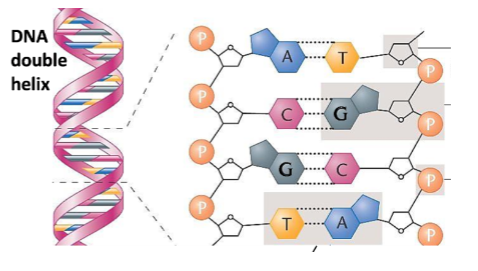
| ⇒ | ⇒ | |||
 |
⇒ | 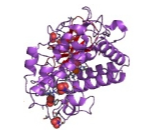 |
⇒ |  |
| ⇒ | ⇒ | |||
| ⇒ | ⇒ |
